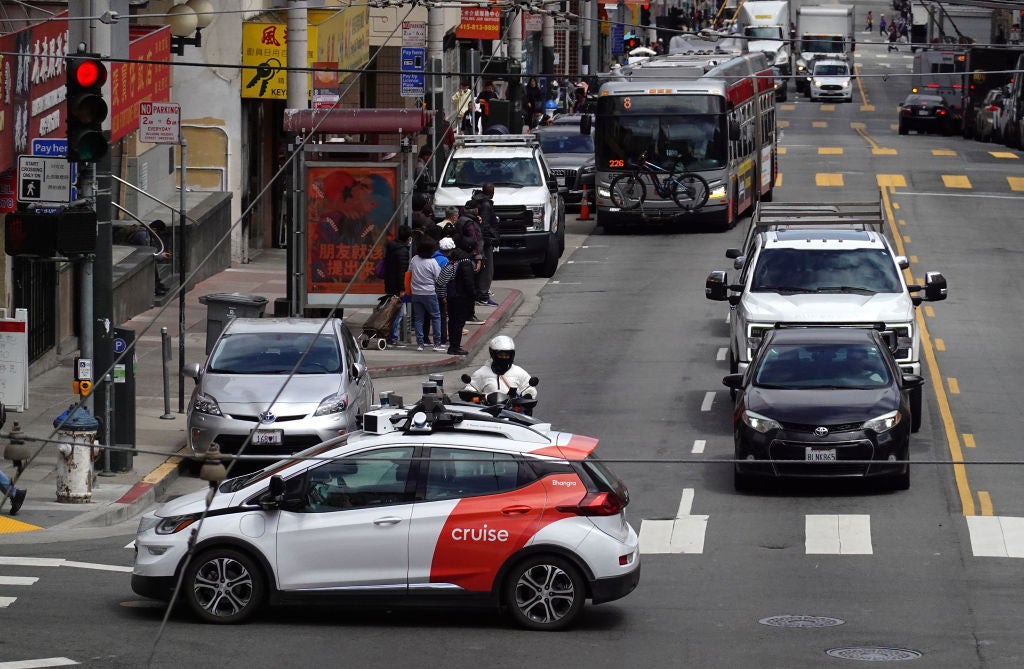Traffic, wet concrete, and a collision with a fire truck: Robotaxis cause chaos in San Francisco after expansion
Critics warned cars weren’t ready for full operations in San Francsico ahead of vote earlier this month
Your support helps us to tell the story
From reproductive rights to climate change to Big Tech, The Independent is on the ground when the story is developing. Whether it's investigating the financials of Elon Musk's pro-Trump PAC or producing our latest documentary, 'The A Word', which shines a light on the American women fighting for reproductive rights, we know how important it is to parse out the facts from the messaging.
At such a critical moment in US history, we need reporters on the ground. Your donation allows us to keep sending journalists to speak to both sides of the story.
The Independent is trusted by Americans across the entire political spectrum. And unlike many other quality news outlets, we choose not to lock Americans out of our reporting and analysis with paywalls. We believe quality journalism should be available to everyone, paid for by those who can afford it.
Your support makes all the difference.On 10 August, California regulators voted to expand the footprint of paid taxi services by autonomous, driverless cars from Cruise and Waymo in San Francisco. Since then, it’s been utter chaos, with the AVs involved in traffic jams, slapstick malfunctions, and a car accident with a fire truck.
A day after the vote, video went viral on social media showing about 10 frozen Cruise taxis snarling traffic in the North Beach neighbourhood, which company officials later said was caused by a connectivity issue due to a spike in cell traffic because of a nearby music festival.
The following Tuesday, a Cruise taxi was stuck in wet concrete at a construction site.
“I can see five different scenarios where bad things happen and this is one of them,” resident Paul Harvey told SFGATE. “It thinks it’s a road and it ain’t because it ain’t got a brain and it can’t tell that it’s freshly poured concrete.”
Two days after that, a Cruise taxi had what might be its most serious accident yet, colliding with a fire truck in the Tenderloin neighbourhood, giving the taxi’s passengers non-severe injuries.
A firefighter in the truck said the AV “lurched” as it passed through an intersection ABC 7 reports, while Cruise said its vehicle detected the emergency sirens but was unable to get out of the way in time from the truck, which drove into the oncoming traffic lane.

“The AV’s ability to successfully chart the emergency vehicle’s path was complicated by the fact that the emergency vehicle was in the oncoming lane of traffic, which it had moved into to bypass the red light,” the company wrote in a statement. “Cruise AVs have the ability to detect emergency sirens, which increase their ability to operate safely around emergency vehicles and accompanying scenes. In this instance, the AV identified the siren as soon as it was distinguishable from the background noise.
“The Cruise AV did identify the risk of a collision and initiated a braking maneuver, reducing its speed, but was ultimately unable to avoid the collision,” the company added.
Following the repeated mishaps, the California Department of Motor Vehicles asked Cruise to cut its 400-strong deployment of AVs in San Francisco in half, with the agency saying it was “investigating recent concerning incidents.”
As The Independent reported, critics of AVs warned ahead of their expansion in San Francisco that the driverless cars weren’t ready for primetime, particularly when it comes to interfacing with emergency vehicles.
According to data Cruise shared with the state earlier this month, between January and mid-July of 2023, Cruise AVs temporarily malfunctioned or shut down 177 times and required recovery, 26 of which such incidents occurred with a passenger inside, while Waymo recorded 58 such events in a similar time frame.
Meanwhile, according to the San Francisco Municipal Transit Agency (SFMTA), between April 2022 and April 2023, Cruise and Waymo vehicles have been involved in over 300 incidents of irregular driving including unexpected stops and collisions, while the San Francisco Fire Department says AVs have interfered 55 times in their work in 2023.
Last year, Cruise lost contact with its entire fleet for 20 minutes according to internal documentation viewed by WIRED, and an anonymous employee warned California regulators that year the company loses touch with its vehicles “with regularity.”
Since being rolled out in San Francisco, robotaxis have killed a dog, caused a mile-long traffic jam during rush hour, blocked a traffic lane as officials responded to a shooting, and driven over fire hoses.
Jeffrey Tumlin, San Francisco’s director of transportation, has called the rollout of robotaxis a “race to the bottom,” arguing Cruise and Waymo weren’t yet definitive transit solutions, and instead had only “met the requirements for a learner’s permit.”



Join our commenting forum
Join thought-provoking conversations, follow other Independent readers and see their replies
Comments